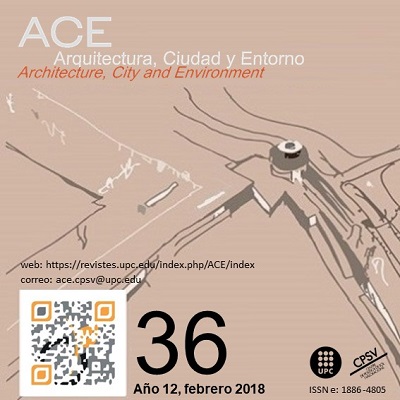Some challenges of recent urbanization in China, five phenomena and one project
DOI:
https://doi.org/10.5821/ace.12.36.4869Keywords:
China, urban planning, strategies, Shanghai Railway StationAbstract
Objectives
The aim of this article is to present a panorama of the problems and challenges that Chinese cities face in the context of accelerated urbanization.
Methodology
In order to do so, we identify five singular phenomena that took place on the last decades in order to study the conflicts with rural and urban population, urban strategies adopted by the administration related to a particular regime of land property. We also explain an awarded project for the transformation of Shanghai Railway Station, based on the comprehension of the phenomena studied previously.
Conclusions
As a conclusion, we can say that, even though today it is very soon to build theories about the way to build cities in China, it is possible to identify certain common practices in the studied phenomena. Many of them have some points in common with western practices, however the scale and speed of developing puts them far away from our cultural experience. Moreover, the study of these phenomena from a western point of view is probably difficult or even nonsense, of course due to the enormous cultural differences but mainly because of the vindication by the Chinese that they are building a new modernity. This new modernity is each year less distant and deserves to be studied in depth.
Originality
This paper develops a reflection based on the study of secondary sources and personal and professional experiences. With this, it pretendes to contribuite to a dynamic field of studies in Spanish language about the urban phenomena on this Asian country.
Downloads
Published
Issue
Section
License
| INTELECTUAL PROTECTION CRITERIA |
At this moment, it is count with the "Oficina Española de Patentes y Marcas", while global protection it is being processed by the World Intelectual Property Organization (OMPI/WIPO). Nevertheless the International Standard Serial Number Office (ISSN) has given the following numbers ISSN: 1886-4805 (electronic version) and 1887-7052 (paper version). All articles will be peer reviewed, using double blind reviewing. |
| COPYRIGHT |
The article contents and their comments are authors exclusive liability, and do not reflect necessarily the journal editor commitee's opinion. All ACE published works are subject to the following licence CC BY-NC-ND 3.0 ES http://creativecommons.org/licenses/by-nc-nd/3.0/es/ It implies that authors do not hold nor retain the copyright without restrictions but only those included in the licence. |


































